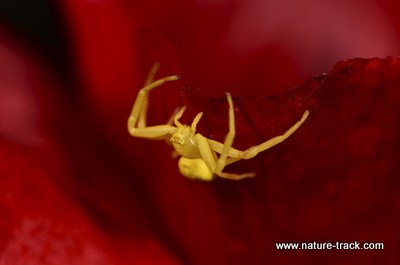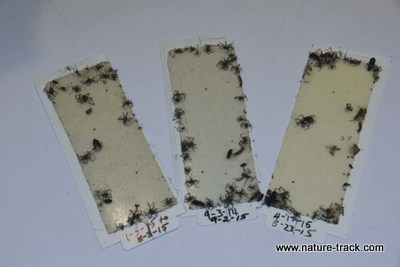Home Invasion

I enjoy watching insects and spiders like this beautiful crab spider, and other invertebrates in my yard. But they cross the line when they invade my home in great numbers.
When a huge spider scurried from the couch to the television, it alerted me that perhaps there might be other spiders in the house. This one was menacingly large and resembled the nasty hobo spider and I decided to check for other invaders.
I could have just had the house “bombed” for spiders. Two of my kids had summer jobs in the Southeast selling pest control services where fumigating for invertebrate house guests is big business. However, I am squeamish about using chemicals inside my residence and I wasn’t even sure it was a problem.
I decided to do a test and see just how many spiders I could catch. I put out a single glue trap at first. When that one started catching spiders and millipedes the very day I put it out, I added to my trapline. Soon I had about a dozen scattered through the house.
I was stunned by my success. My home is only 15 years old and I would have expected it to be more critter resistant. However, it would appear that we sleep with the doors wide open and without screens on the windows.
In the course of a year, I caught hundreds of critters. Besides spiders ranging from pinhead sized to behemoths with a legspan that would lap over a quarter (I did think about the irony of spiders getting caught in sticky traps), there were half dozen species of beetles, ants, millipedes, pillbugs, flies, moths and even a mosquito.
Strangely, there were no harvestman spiders (daddy longlegs). As common as these are in my yard, I would have expected to at least pick up the occasional one on a glue trap. One trap did have mouse hair though, indicating that while I have won the war with the mice, there will always be guerrilla fighters that routinely test my defenses.
I understand that having a few house spiders around can actually reduce the number of other invaders. However, judging by what I caught, I have more than a few spiders and frankly, I can’t tell if they are hobos or the generic house spider, of which there are numerous species. But with grandkids crawling through the house and an expected houseful of guests at Thanksgiving, I am afraid it is a case of guilt by association. They have exceeded my tolerance threshold, whether hobo or house spider.
To set my traps, I cut the cardboard back to the glue on one long edge. This is challenging because that glue is the stickiest stuff I have ever seen and will quickly gum up a blade. Bugs and spiders like to travel along walls, so I place the trimmed edge up against a wall somewhere where kids and pets won’t find it.
Fall is the time when the invasion cranks up as little critters try to share our warm dry homes. I regret having to go to war with creatures that just want to live. But I have to draw the line when they cross the threshold of my home.

These three glueboards came from different locations in one room in my basement. In place from eight months to a year, they caught almost 200 invertebrates.

Wildlife License Plates
Great news! as of 2024, there are three NEW designs for license plates. They still are bluebird, cutthroat trout and elk, but they are beautiful.
Idaho Wildlife license plates provide essential funding that benefits the great diversity of native plants and wildlife that are not hunted, fished or trapped—over 10,000 species or 98% of Idaho’s species diversity. Game species that share the same habitats (such as elk, deer, antelope, sage-grouse, salmon, trout) also benefit from these specialty plates.
No state tax dollars are provided for wildlife diversity, conservation education and recreation programs. Neither are any revenues from the sale of hunting or fishing licenses spent on nongame species. Instead, these species depend on direct donations, federal grants, fundraising initiatives—and the Idaho Wildlife license plates.
Both my vehicles have Bluebird Plates. I prefer the bluebird because the nongame program gets 70 percent of the money from bluebird plates, but only 60 percent of the money from elk and trout plates - 10 percent of the money from elk plates supports wildlife disease monitoring and testing programs (to benefit the livestock industry) and 10 percent from cutthroat plates supports non-motorized boat access.
Incidentally, in 2014, the Idaho Legislature denied the Department of Fish and Game the ability to add new plates or even to change the name of the elk and cutthroat plates (very specific) to wildlife and fish plates, a move that would have allowed for changing images occasionally and generating more revenue. It would seem that they believe that we Idahoans don't want a well funded wildlife program.
I think it is time we let the Legislature know that Idahoan support wildlife funding and that we would like to see these generic plates come to fruition.

"WOW. What a phenomenal piece you wrote. You are amazing." Jennifer Jackson
That is embarrassing, but actually a fairly typical response to my nature essays. Since The Best of Nature is created from the very best of 16 years of these nature essays published weekly in the Idaho Falls Post Register (online readership 70,000), it is a fine read. It covers a wide variety of topics including humorous glimpses of nature, philosophy, natural history, and conservation. Readers praise the style, breadth of subject matter and my ability to communicate complex and emotional topics in a relaxed and understandable manner.
Everyone can find something to love in this book. From teenagers to octogenarians, from the coffee shop to the school room, these nature essays are widely read and enjoyed.
Some of the essays here are my personal favorites, others seemed to strike a chord with readers. Most have an important message or lesson that will resonate with you. They are written with a goal to simultaneously entertain and educate about the wonderful workings of nature. Some will make you laugh out loud and others will bring a tear to the eye and warm your heart.
Readers Write:
"You hit a home run with your article on, Big Questions in Nature. It should be required reading for everyone who has lost touch with nature...great job!" Joe Chapman
"We enjoyed your column, Bloom Where Planted. Some of the best writing yet. The Post Register is fortunate to have your weekly columns." Lou Griffin.
To read more and to order a copy, click here or get the Kindle version
Copies are also available at:
Post Register
Island Park Builders Supply (upstairs)
Barnes and Noble in Idaho Falls
Harriman State Park, Island Park
Museum of Idaho
Valley Books, Jackson Wyoming
Avocet Corner Bookstore, Bear River National Wildlife Refuge, Brigham City, Utah
Craters of the Moon National Monument Bookstore, Arco, Idaho